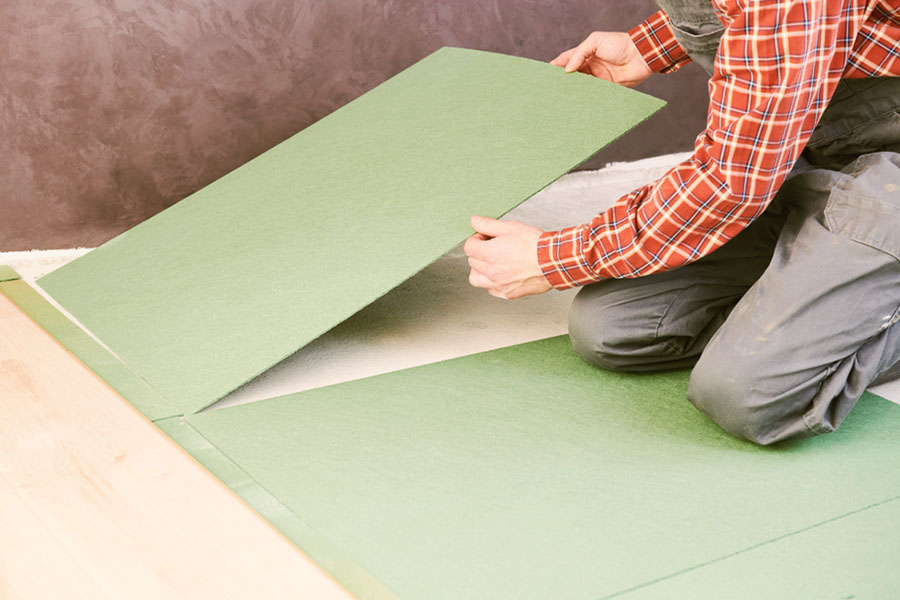Does Underlayment Help with Uneven Floors?

Uneven floors pose a challenge when installing new flooring, compromising both aesthetics and functionality. While addressing major unevenness through floor repairs is ideal, it’s often costly.
Does underlayment help with uneven floors? The question arises as underlayment offers a practical solution as a thin layer between the subfloor and final flooring.
Can underlayment address minor subfloor imperfections and unevenness? This comprehensive guide explores the effectiveness of underlayment in dealing with uneven floors.
By understanding the different types and capabilities of underlayment, homeowners and professionals can choose an option that minimizes flooring issues. It will also help them address subfloor imperfections during installation.
By the end, you will know how to leverage underlayment as a practical solution for uneven subfloors. Addressing unevenness is crucial for achieving a seamless, functional, and aesthetically pleasing flooring installation that stands the test of time.

Source: shutterstock.com / Photo Contributor: anatoliy_gleb
Does Underlayment Help With Uneven Floors?
Yes, underlayment can assist with uneven floors by providing a smooth surface for new flooring. It helps to level out minor imperfections in the subfloor, enhancing stability and comfort during installation.
However, for significant unevenness or structural issues, additional measures may be required. While underlayment can improve the situation, it’s essential to assess the severity of the unevenness and consider professional advice if needed for a proper solution.
Understanding Uneven Floors
Causes of unevenness
Uneven floors refer to surfaces that lack a consistent level or plane, with variations in height or slope across different areas.
One common cause is settling over time due to soil movement or foundation issues, leading to the formation of dips, slopes, or high spots. Moisture problems like water damage or excessive humidity can also cause floors to swell, warp, or buckle, resulting in unevenness.
Types of unevenness
Dips are low spots or depressions caused by settling or moisture issues, posing trip hazards. Slopes refer to gradual inclines or declines, often from foundation issues or improper installation. High spots are raised areas protruding above the surrounding surface, often due to subfloor problems or uneven underlayment installation.
These irregularities can compromise aesthetics, cause uneven wear, and lead to structural issues if left unaddressed.
Addressing uneven floors
Understanding the causes and types of uneven floors allows homeowners and professionals to assess the extent of the issue. They can then determine appropriate solutions. These may involve addressing the underlying cause or exploring options like underlayment to mitigate the impact on new flooring installations.
How Does Underlayment Help With Uneven Floors
Underlayment can provide a smoother surface by bridging minor subfloor imperfections like dips, slopes, or high spots. It can enhance aesthetics and improve flooring longevity
However, underlayment has limitations with significant unevenness. Major issues require extensive floor leveling solutions instead of just underlayment. Proper floor leveling measures are essential.
They include using self-leveling compounds or grinding before installing underlayment and final flooring, especially for severe unevenness. Underlayment should be combined with, not replaced, leveling techniques for best results on uneven floors.
Choosing the Right Underlayment for Uneven Floors
When selecting underlayment for uneven floors, consider the final flooring material, the degree of unevenness, and the properties of the underlayment. For mild unevenness, thin options like cork or foam may suffice.
For moderate slopes, denser materials like fiberboard or cork/rubber blends are more suitable. Severe irregularities require self-leveling compounds or poured underlayments first to create a smooth surface.
Evaluate the underlayment’s thickness to bridge gaps, flexibility to conform to uneven surfaces, and compressive strength for high-traffic areas. Choose the right underlayment based on your project’s specific needs for a smooth, long-lasting installation.

Source: shutterstock.com / Photo Contributor: Farhad Ibrahimzade
Preparing an Uneven Floor for Underlayment Installation
Before installing underlayment on an uneven floor, proper preparation is crucial to ensure a successful and long-lasting result. The first step in this process is to thoroughly clean the subfloor, removing any dirt, debris, or contaminants that may interfere with the adhesion of the underlayment.
A clean surface provides a solid foundation for the subsequent steps. Once the subfloor is cleaned, it’s essential to carefully inspect and assess the level of unevenness present.
Note any dips, slopes, or high spots that need to be addressed before proceeding. This assessment will guide the necessary repairs or leveling techniques. It will create a suitable surface for the underlayment installation.
Necessary repairs and leveling
For minor imperfections, such as small dips or cracks, using an appropriate floor patching compound can be an effective solution. These compounds can be applied to fill in the imperfections, creating a smoother surface.
It’s important to allow the patching compound to dry completely before proceeding with the next step. In cases of severe unevenness or structural issues, it’s advisable to consult with a flooring professional.
Major repairs may be required to address significant irregularities or underlying problems before installing the underlayment. Professionals may employ specialized techniques or equipment to tackle these challenges effectively.
Leveling techniques
Depending on the extent of unevenness, various leveling techniques may be employed. For moderate irregularities, self-leveling compounds can be applied to create a smooth, level surface.
These compounds are designed to flow and level out, effectively filling in dips and smoothing out slopes. It’s crucial to follow the manufacturer’s instructions carefully, ensuring proper application and allowing sufficient drying time.
In some cases, floor grinding may be necessary to remove high spots or level out particularly uneven areas. This process involves using specialized equipment to grind down the elevated sections of the subfloor, creating a more uniform surface.
Installation Tips for Maximizing Underlayment Benefits
While selecting the appropriate underlayment for your uneven floors is essential, proper installation techniques are equally critical to maximize its benefits. During the installation process, it’s essential to handle the underlayment materials with care. This helps avoid creases, tears, or other damage that could affect their performance.
Precise cutting around obstacles or irregular areas is also crucial for a proper fit and effective support of the final flooring. It cannot be overstated that careful installation is key to maximizing the benefits of underlayment when dealing with uneven floors.
Any gaps, movement, or improper installation can undermine the underlayment’s ability to provide a stable base for the final flooring material. Proper installation ensures even support and contributes to the longevity of your flooring investment.

Source: shutterstock.com / Photo Contributor: Dmitry Kalinovsky
Conclusion
Does underlayment help with uneven floors? Underlayment can offer an effective solution for addressing minor unevenness in subfloors during a flooring installation. By providing a smooth, level surface, the right underlayment helps bridge minor dips, slopes, and high spots, enhancing the overall aesthetic and longevity of the final flooring.
However, it’s crucial to understand the limitations of underlayment and combine it with necessary repairs and leveling techniques for severe unevenness or structural issues. Proper subfloor preparation, including cleaning, patching, and leveling, is essential before installing the underlayment.
Hopefully, you have it clear how to leverage the benefits of underlayment and address any significant unevenness, to achieve durability.
Remember, while underlayment can help with uneven floors, it should be considered a complementary solution rather than a complete fix for major irregularities.
